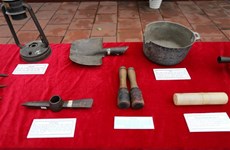Urban areas in urgent need of greenery
Vietnam’s urban areas are in urgent need of greenery, forestry experts
said, citing very low green coverage in most cities in the country, at
an average 0.5 sq. m per capita compared to “green urban” standards of
10 sq. m.
Vietnam’s urban areas are in urgent need of greenery, forestry experts
said, citing very low green coverage in most cities in the country, at
an average 0.5 sq. m per capita compared to “green urban” standards of
10 sq. m.
Statistics of the forestry sector showed the ratio in Hanoi was only 2 sq. m and in Ho Chi Minh City, 3.3 sq. m.
As a result, the environment, particularly air quality, in Vietnamese urban areas is degrading.
On a larger scale, forests across the country also fail to produce required effect on regulating climate, reducing green house gas and cushioning natural disasters such as flood and landslide, despite an increase in coverage, the 2013 National Environmental Report said.
The total forest area expanded by 138,461 ha to reach 10,423,844 million hectares in 2012, but forest’s quality showed signs of degradation. Most of the current forests are classified as economic forest including industrial and paper-material trees, which have little value in terms of ecology.
The acreage of primeval forests, which are mostly in the Central Highlands and Northwestern areas, is shrinking due to deforestation for agriculture development.
Last November, the Prime Minister has approved a master plan on development of the national special-use forest system through 2020, with a vision to 2030.
Under the plan, the entire special-use forest coverage will be expanded from the current 2.2 million hectares to 2.4 million hectares by 2020.
The 2.4 million ha will cover 34 national parks, 58 nature reserves, and numerous landscapes and research areas.
The northwest region will have 222,000ha of special-use forest, including a new nature reserve at Muong La with an area of 17,000ha, while 400,000ha will be zoned off in the northeast region.
Meanwhile, the Red River Delta will have 65,000ha of protected forests, aiming to preserve the local ecosystems on lime mountains and wetlands as well as the forests with close connection to the region’s culture, history and landscapes in Hanoi and the provinces of Ninh Binh, Hai Duong and Nam Dinh.-VNA
Statistics of the forestry sector showed the ratio in Hanoi was only 2 sq. m and in Ho Chi Minh City, 3.3 sq. m.
As a result, the environment, particularly air quality, in Vietnamese urban areas is degrading.
On a larger scale, forests across the country also fail to produce required effect on regulating climate, reducing green house gas and cushioning natural disasters such as flood and landslide, despite an increase in coverage, the 2013 National Environmental Report said.
The total forest area expanded by 138,461 ha to reach 10,423,844 million hectares in 2012, but forest’s quality showed signs of degradation. Most of the current forests are classified as economic forest including industrial and paper-material trees, which have little value in terms of ecology.
The acreage of primeval forests, which are mostly in the Central Highlands and Northwestern areas, is shrinking due to deforestation for agriculture development.
Last November, the Prime Minister has approved a master plan on development of the national special-use forest system through 2020, with a vision to 2030.
Under the plan, the entire special-use forest coverage will be expanded from the current 2.2 million hectares to 2.4 million hectares by 2020.
The 2.4 million ha will cover 34 national parks, 58 nature reserves, and numerous landscapes and research areas.
The northwest region will have 222,000ha of special-use forest, including a new nature reserve at Muong La with an area of 17,000ha, while 400,000ha will be zoned off in the northeast region.
Meanwhile, the Red River Delta will have 65,000ha of protected forests, aiming to preserve the local ecosystems on lime mountains and wetlands as well as the forests with close connection to the region’s culture, history and landscapes in Hanoi and the provinces of Ninh Binh, Hai Duong and Nam Dinh.-VNA













